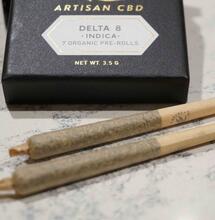Cannabis: A History Through Medicine

Cannabis was first used as medicine in 2737 BC in China. The earliest recorded use of cannabis as a medication is attributed to the legendary Emperor Shen Nung, who lived between 2696 and 2737 BC. Nung was celebrated as a scholar, farmer, and hemp enthusiast. His documentation of the plant's 'yin energy' for treating ailments such as malaria, dysentery, constipation, and rheumatic discomfort is believed to be the first entry in a medicinal encyclopedia.
There are also records of medicinal cannabis use in the Egyptian Ebers Papyrus, a medical manuscript dating back to approximately 1550 BC, which describes its application for treating pain, fever, and uterine contractions.
In the Mediterranean region, Dioscorides, a physician to the Roman Emperor Nero, documented cannabis as a remedy for ear pain. Between the 8th and 18th centuries, evidence suggests that the Arab world utilised cannabis as a painkiller, anti-inflammatory, and anti-epileptic agent.
When Was Cannabis First Used in the West?
In the West, documented use of cannabis was extremely limited until the 17th century, when global trade began to increase. In 1621, English clergyman Robert Burton introduced cannabis as a remedy for depression in his publication, *The Anatomy of Melancholy*. Following that, Irish physician William Brooke O'Shaughnessy ventured into medical experimentation with cannabis in Western medicine.
Working in India from 1833, O'Shaughnessy studied the indigenous strain known as Cannabis Indica (Hindu Kush), which had been used in India for thousands of years. Despite some ethically questionable testing practices, he concluded that cannabis was a wonder drug that could help treat conditions such as rheumatism, rabies, infantile convulsions, cholera, tetanus, and delirium from alcohol withdrawal.
The *Provincial Medical and Surgical Journal*, which later became the British Medical Journal, featured cannabis prominently on its front page. Its popularity as a painkiller grew in the UK, and Queen Victoria was even prescribed cannabis by her private physician to alleviate menstrual pain and discomfort following childbirth.
However, anxiety about the drug began to rise throughout the 19th century, with critics linking its use to madness. Thisculminated in the Indian Hemp Drugs Commission report of 1894, which assessed the social and medicinal use of cannabis in the region. The report concluded that while excessive amounts of cannabis might be harmful, moderate use could benefit those in malaria-endemic areas.
Despite this, the association between cannabis and mental illness lingered. Pharmaceutical companies became less interested in cannabis with the advent of the syringe, which allowed for easier formulation of drugs like morphine into injectable fluids. Cannabis, in contrast, is insoluble and does not readily dissolve in water.
Why Was Cannabis the Victim of Prohibition?
The most significant damage to the reputation of cannabis occurred in the 1900s due to Henry Anslinger, an American prohibition officer. Anslinger propagated racist narratives and instilled cannabis paranoia to sway public opinion towards its prohibition. Until 1928, cannabis was legal worldwide.
During this period, the media began to frame narratives linking cannabis to Mexican immigrants, resulting in the term 'marijuana' becoming popular. This spelling modification was intended to rhyme with the city "Tijuana" and emphasise its Mexican roots. Media outlets spun sensational stories about ethnic minorities using marijuana and behaving violently, often portraying them as threats to white women. Interestingly, many wealthy media moguls of the time were significant investors in the lucrative cotton industry, which saw hemp as a direct competitor.
This provided ample motivation to tarnish the reputation of anything related to cannabis or hemp. As a result, cannabis has been predominantly associated with recreational use and exaggerated links to mental health issues ever since.
Medicinal Cannabis Use in Britain
In Britain, cannabis-based products could still be prescribedon the NHS until 1973. It was only after the Misuse of Drugs Act that cannabis was classified as having "no known medical use."
Nonetheless, the medical benefits of cannabis continued to be a topic of debate. Pharmaceutical manufacturers recognised the potential market for cannabis-based products. Over time, therapeutic uses began to emerge, including appetite suppression, anti-sickness remedies, pain management, and treatment for glaucoma, asthma, and multiple sclerosis (MS).
Further interest in cannabis as medicine grew in the 1990s with the discovery of the endocannabinoid system—a self-regulating network controlled by the body’s self-produced cannabinoids, known as endocannabinoids. This system is believed to serve various functions, including pain and movement management, nerve protection, and other potential benefits.
For decades, the government remained reluctant to acknowledge cannabis-based medicines until it had solid clinical evidence of their efficacy. However, stringent regulations around cannabis made it challenging for companies to conduct thorough research.
More From Soft Secrets:
Cannabis and Medication Interactions
80% of NHS Doctors Would Prescribe Cannabis for Women's Health Issues








